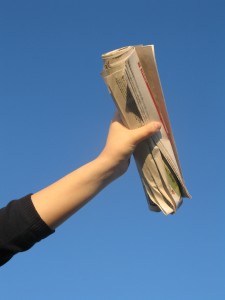
Photo courtesy of SXC.
For this month’s link roundup, good things seem to come in twos.
Conversations on a “sick” topic
We’ve all heard about the health-care reform legislation that is making its way through Congress on the news, but how good is the coverage of health issues in general. I saw a pair of articles recently had experts giving a guarded prognosis to the current state of health journalism.
In a Columbia Journalism Review “Talking Shop” column, Los Angeles Times health reporter Karen Ravn, who recently had her story about patient dishonesty, “Body of Lies,” published in her paper, discussed the future of her specialty with Sanhita Reddy.
Ravn had an interesting point to make about the role of health blogs in the public’s perception of medical information:
“I noticed … (on WSJ’s Health Blog!) that a new survey from the Pew Research Center found that 25 percent of all American adults have read someone else’s commentary or experience about health or medical issues on an online news group, Web site, or blog. More generally, 61 percent look online for health information, and 42 percent say they or someone they know has been helped by info found on the Internet, while only 3 percent say they or someone they know has been harmed by info found on the Internet. These figures suggest that blogs and other Internet sources are playing a largely useful role in health awareness.
“Blogs have the benefit of letting readers interact with writers: ask questions, make contrary points, describe personal experiences (that other readers then get to share). On the other hand, not all blogs are as responsible as the NYT’s and the WSJ’s may be assumed to be. And quality control on reader postings ranges from limited to nil. … I regret (understatement) any extent to which health reporting is a zero-sum game—where the growth of health blogs on the Web means the shrinkage of health sections in the paper.”
Over at the University of Minnesota’s alumni magazine, there is a great interview with Gary Schwitzer, an associate professor in the School of Journalism and Mass Communication at the University of Minnesota who is an expert on health journalism. Schwitzer publishes an award-winning Web site critiquing health care journalism, maintains a health-related news and resource site, and is helping to train the next generation of health care journalists.
In “Sick About Health Care,” Schwitzer is especially critical of the way journalists cover disease and treatment.
“It’s a troubling time and there isn’t time to waste space or air time or column inches on breakthroughs and cures and miracles and fluff. We’re not asking tough questions: What’s the quality of evidence? Who’s going to have access to it? What’s it going to cost? Who’s your source? What are his or her conflicts of interest? This is not only a lesson for journalists, but a lesson for consumers. These are things we should be asking of anyone who makes health care claims. Including your own caregiver…”
He also has tough words for the medical, drug and insurance industries:
“We are over-medicalized. We sell sickness. We fearmonger. We disease-monger. We are actually again being sold on the weapons of mass destruction in our lives, but these are weapons of mass destruction inside us. You’d better have a scan, although nothing is wrong with you. Under the banner of doing good we are doing harm.”
Both articles are excellent ways to inform yourself about the quality of reporting being done on this urgently important topic. Schwitzer also mentions the work of AP medical writer Carla Johnson, who has utilized her attendance at evidence-based journalism workshops to produce stories that take a close look at the results of a new treatment or approach before hailing it as a “breakthrough” or “miracle” (which are two words Schwitzer says health writers should never use).
Cyber-journalism and linking: making it click
BeatBlogging.com had a couple of nice links recently relating to the ethics of hyperlinking and tools that may enable reporters to be even more wired and mobile than ever.
In “Why We Link,” Ryan Sholin discusses why outside links are not just good in a news story, but vital. For those involved in online writing who are not trained in journalism, this may seem like a no-brainer, but there are significant questions of accuracy and quality of link-based information that traditional journalists have rightly raised.
Sholin lists five reasons why linking often and intelligently benefits journalists, and one of his best arguments is that it is one of the best ways to connect with the online community in one’s town:
“If you’re writing about human beings, businesses, organizations, government institutions or any other life form with a presence on the Internet, linking to them in the stories you publish about them is the low-hanging fruit when it comes to participating in your local online community.
“Skipping the link to the city council’s calendar when you mention the next meeting, leaving out the link to the Little League’s online scoreboard when you write a story about its resurgence or not bothering to link to the full database of restaurant inspections when you choose three to write about — these are all easy ways to miss an opportunity to connect with your community and your readers.”
Meanwhile, the same week that the above article came out, BeatBlogging also published a post by Patrick Thornton on tools that may help redefine reporting. He discusses MiFi networks (which are like small-scale Wi-Fi wireless networks), the newest iPhone (which can easily edit and share, as well as record, video and photos), and the increasing affordability of digital cameras and netbooks.
All this points to reporters being able to blend online research and good old-fashioned legwork out in the field, Thornton says. It also means the days of hearing “that’s not my job” in the newsroom (or over the phone!) are gone.
“The era of specialized journalists may be coming to an end. By specialized, I mean people who only write, edit, take photos, etc. Most content producers should be able to at least write and take competent photos and video. A news org may still want a few dedicated photographers and videographers around for big stories and high-end content. Journalists will probably be specializing more in beats and niches and less in a specific content production means.”
I agree with Thornton on this last point, and argue (as a writer and editor with video production experience) that once one gets to a certain point with tool knowledge, what counts in producing media content is the ability to frame a story and tell it well, not one’s expertise in a niche skillset.
Bonus Links!
Even our bonus links are a two-fer this time. Both are from Mashable.com.
Everything I Need to Know About Twitter I Learned in J-School
Great description of parallels between reporter training in journalism school and successful Twitter posts.
Nonfiction Tweets: 70+ Authors to Follow on Twitter
Lists Twitter feeds for numerous nonfiction writers from various genres.









